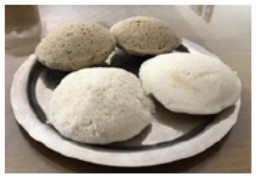By K S Venkataraman ThePatrika@aol.com

Indian dals contain proteins between 15% and 25%. Protein-rich dals have low glycemic indexes compared to white rice. The proteins in individual dals, made up of amino acids as building blocks, do not contain all the nine essential amino acids (histidine, isoleucine, leucine, lysine, etc.) our body needs. Hence vegetarians need a combination of several dals plus seeds/nuts, tofu, and milk products to get complete proteins.
I. Ingredients:
In the list below, broken lentils with the husk/skin intact are given because they soak quicker. Unbroken lentils are a better choice, but they need longer soaking times. The husk/skin is a good source of fiber.
1. Chana dal: 1 measure (use any volume measure)
2. Toor dal: 1 measure
3. Broken sabut Urad with the husk/skin intact): 1 measure
4. Broken sabut moong with husk: 1/2 measure
5. Broken Red Mung Beans: 1/2 measure
6. Boiled rice (this is not parboiled rice and not cooked rice): 2 measures. Note: This is a unique South Indian rice available in Indian stores. One brand is Ponni Puzhungal Arisi (Boiled Rice).
7. Options: Red chillies, cumin seeds, black pepper, ginger, to taste
Note: In the above, rice is only ~33% of the total. In white idly batter, rice content is between 60% – 80%. This alone reduces the glycemic load in this recipe.

II. Soaking: In lukewarm water soak all in one vessel for at least 4 hours if you use broken dals. Unbroken lentils take a longer soaking time. Wash the soaked grains in water.
III. Making the Idly Batter: Go to YouTube to see the consistency of the idly batter and for idly making techniques. The common run-of-the-mill kitchen blender is a bad choice for wet grinding since it gets quite warm heating up the batter. The rugged high-wattage Vita Mix blender may work. Traditional Indian wet grinders are the best.
Wet-grind the soaked grains until the batter is very smooth. If there is too much water, the batter becomes too thin, and is not good for making idlies. Transfer the batter into a large vessel. Add salt to taste and mix it well. If you added too much water during grinding, you can still salvage the batter for making dosai-equivalent. ;–)))
IV. Fermenting the batter: This is critical. Keep the wet-ground batter at temperatures between 70 F to 80 F for at least 8 hours for it to ferment. The batter, when fermented, will rise in the container with tiny air bubbles filling the space. That is why you need a large vessel.
V. Making the idlies: If the fermented batter is too thick, add a small quantity of water and gently mix the batter using a spatula. Do not beat the batter too much. This drives away all the air bubbles. The trapped tiny air bubbles make the idlies spongy.
Pour the batter on the idly-making plate and steam-cook it — NO pressure cooking — for 10 minutes minimum. Take out the idly plates from the steamer and cool. Scoop out the idlies from the idly plate.
In the picture shown on the top, the regular idlies are in the front and the high-protein idlies are in the back. The high-protein idlies are darker because of the dals and the husk/skin in the batter. Eat these idlies with Molagai Podi (known as gun powder in north India) or chutneys. ♠
